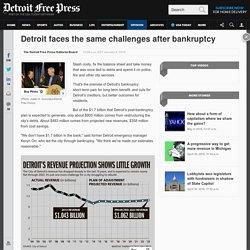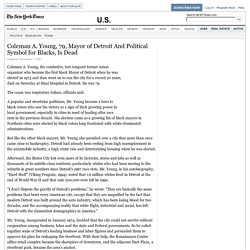

Taxes fall in Detroit neighborhoods. Many Detroit homeowners will see their property tax assessments drop 5%-15% this year, although bustling downtown and Midtown will see an increase of 5%, city officials said Monday.

After bankruptcy, few options for Detroit to grow revenue. Slash costs, fix the balance sheet and take money that was once tied to debts and spend it on police, fire and other city services.

That's the premise of Detroit's bankruptcy: short-term pain for long-term benefit, and cuts for Detroit's creditors, but better outcomes for residents. But of the $1.7 billion that Detroit's post-bankruptcy plan is expected to generate, only about $900 million comes from restructuring the city's debts. About $483 million comes from projected new revenues, $358 million from cost savings. State prepares to collect city income taxes for Detroit. Detroiters and people who work in the city will be able to pay their individual city income taxes electronically starting with the next tax season after the state Treasury Department begins processing the city’s income tax collections in January, officials said today.

The state is taking over Detroit income tax collection as part of the city’s post-bankruptcy efforts to improve its bottom line, and the Treasury Department will begin processing the taxes in January. The move will make it easier to file taxes while also boosting compliance, likely resulting in increased revenue for the city, the officials said. “Taxpayers deserve an easy and convenient filing process and the ability to e-file directly with the state will do just that,” Detroit Chief Financial Officer John Hill said in a news release.
“More efficient tax collection also means the city will have more resources to provide vital services to our citizens.” Forbes Welcome. Cities on the Brink. Detroit's population loss slows; some suburbs see gains. Detroit continues to lose residents, but the population loss appears to be slowing, with about 1% moving out between 2013 and 2014, according to estimates released today by the U.S.

Census Bureau. In the tri-county area, the Oakland County suburbs of Lyon and Oakland townships and Sylvan Lake, as well as Macomb and Washington townships in Macomb County grew the fastest, according to the estimates. The census makes the estimates annually based on a review of birth and death records, as well as migration. Demographer Kurt Metzger said Detroit's population loss appears to be easing. "It continues to average about 1% loss per year," said Metzger, now mayor of Pleasant Ridge.
Whites moving to Detroit, city that epitomized white flight. Whose Neighborhood Is It? Photo On June 25, 1974, suburban residents of Detroit won their four-year battle to overturn court-ordered busing of black city students across county lines into their schools.

In a key 5-4 Supreme Court decision, Milliken v. Bradley, Chief Justice Warren Burger declared that 41 white suburban governments had not committed “significant violations” of the Constitution. Burger wrote: No single tradition in public education is more deeply rooted than local control over the operation of public schools; local autonomy has long been thought essential both to the maintenance of community concern and support for public schools and to quality of the educational process. The victory in Milliken was based on the assumption that African-Americans would be bused in, not that they would be living next door.
Southfield, Mich., for example, which had been 0.7 percent black in 1970, by 2010 had become 70.3 percent black, and its schools nearly 95 percent black. Forbes Welcome. Whites moving into Detroit, blacks moving out as city shrinks overall - Crain's Detroit Business. Anatomy of Detroit’s Decline - Interactive Feature. Mayor Coleman A. Young of Detroit at an event in 1980. Richard Sheinwald/Associated Press The financial crisis facing Detroit was decades in the making, caused in part by a trail of missteps, suspected corruption and inaction. Here is a sampling of some city leaders who trimmed too little, too late and, rather than tackling problems head on, hoped that deep-rooted structural problems would turn out to be cyclical downturns.
Charles E. Detroit Population Down 25 Percent, Census Finds. Coleman A. Young, 79, Mayor of Detroit And Political Symbol for Blacks, Is Dead. Coleman A.

Young, the combative, tart-tongued former union organizer who became the first black Mayor of Detroit when he was elected in 1973 and then went on to run the city for a record 20 years, died on Saturday at Sinai Hospital in Detroit. He was 79. The cause was respiratory failure, officials said. A popular and streetwise politician, Mr. Young became a hero to black voters who saw his victory as a sign of their growing power in local government, especially in cities in need of healing after race riots in the previous decade.
The Old Neighborhood. A Dream Still Deferred. AT first glance, the numbers released by the Census Bureau last week showing a precipitous drop in Detroit’s population — 25 percent over the last decade — seem to bear a silver lining: most of those leaving the city are blacks headed to the suburbs, once the refuge of mid-century white flight.

But a closer analysis of the data suggests that the story of housing discrimination that has dominated American urban life since the early 20th century is far from over. In the Detroit metropolitan area, blacks are moving into so-called secondhand suburbs: established communities with deteriorating housing stock that are falling out of favor with younger white homebuyers.
If historical trends hold, these suburbs will likely shift from white to black — and soon look much like Detroit itself, with resegregated schools, dwindling tax bases and decaying public services.